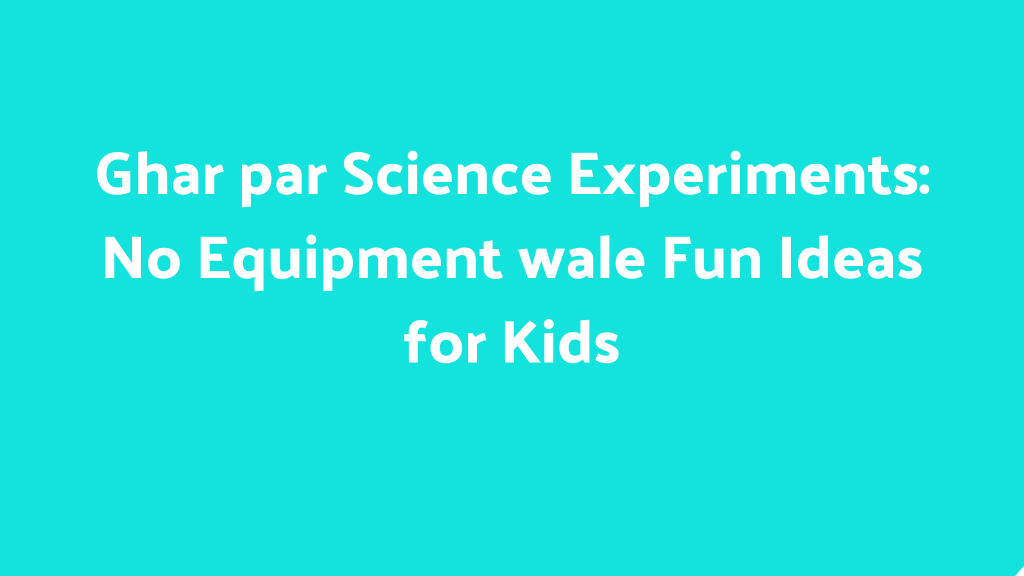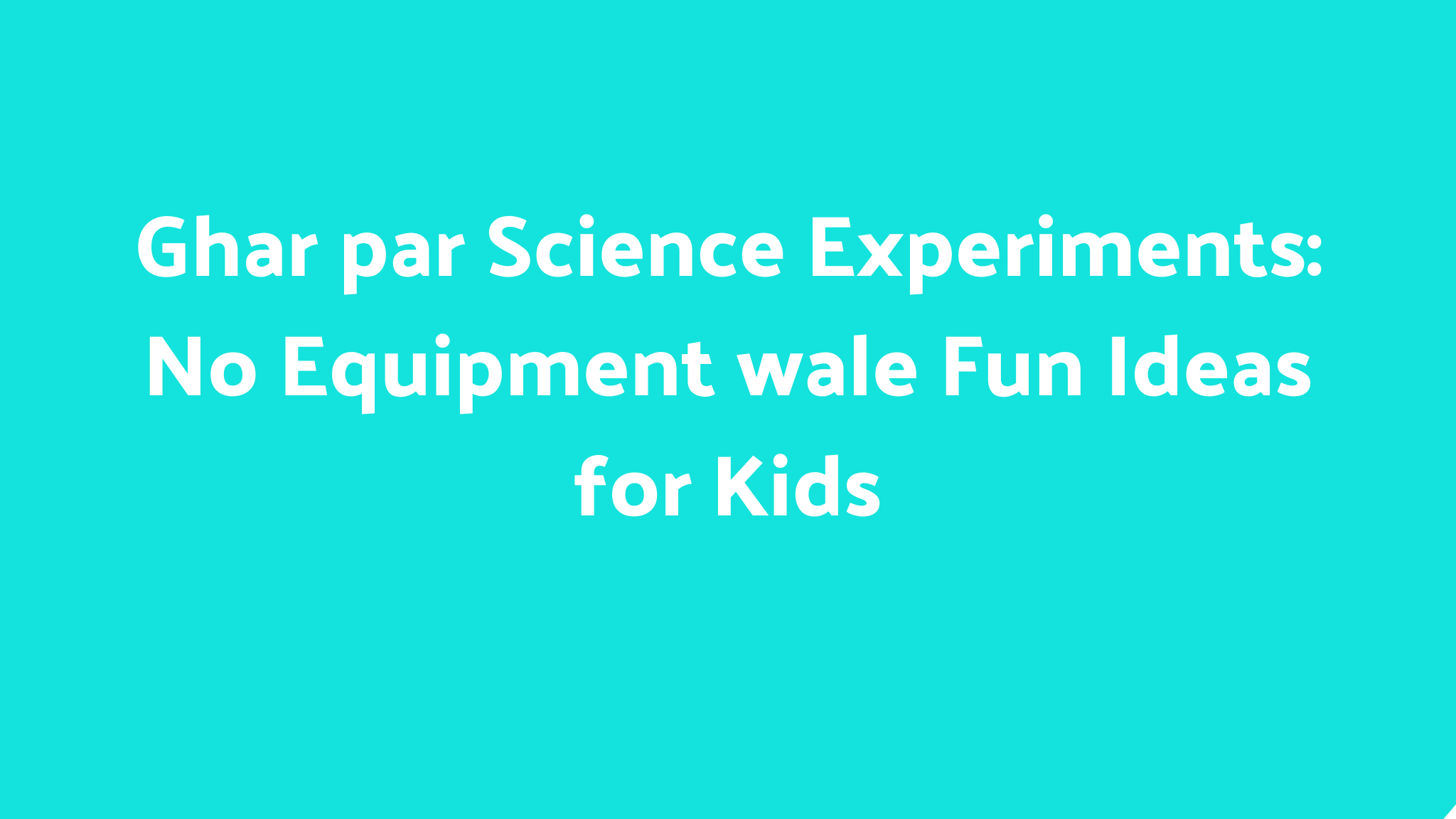Ghar Par Science Experiments: No-Equipment Wale Fun Ideas for Kids
Science isn’t confined to labs or fancy gadgets—it’s hiding in every corner of your home, waiting to be discovered! For kids, the world is a giant playground of curiosity, and with a little creativity, everyday items can transform into tools for thrilling experiments. The best part? You don’t need specialized equipment. From kitchen chemistry to backyard biology, here’s how to turn your home into a science lab that sparks wonder, critical thinking, and endless fun.
Table of Contents
Why “No-Equipment” Science Rocks
Before diving into experiments, let’s address the elephant in the room: Why skip the lab gear? For starters, accessibility matters. Not every family has microscopes or Bunsen burners, but everyone has salt, water, or a balloon. According to a 2022 study in Science Education, hands-on, low-cost experiments improve retention and engagement in kids by 40% compared to passive learning. Plus, improvisation teaches problem-solving—a core scientific skill!

Dr. Anika Rao, a Mumbai-based STEM educator, puts it simply: “When kids use household items for experiments, they realize science isn’t ‘magic’—it’s the logic behind everyday things.”
Kitchen Chemistry: Edible Science - Ghar Par Science Experiments
The kitchen is a treasure trove of chemical reactions. Here’s how to whip up some edible science:
1. Dancing Raisins (Ages 5+)
What You Need: A glass, soda (any fizzy drink), raisins.
What to Do: Fill the glass with soda and drop in 4-5 raisins. Watch them “dance” as bubbles attach to their wrinkled surface, float up, and sink again.
Science Unpacked: Carbon dioxide bubbles act like tiny life jackets for the raisins. When the bubbles pop at the surface, the raisins sink—only to repeat the cycle!
2. Magic Milk Art (Ages 6+)
What You Need: Milk (full-fat works best), food coloring, dish soap, a cotton swab.
What to Do: Pour milk into a plate, add drops of food coloring, then dip the swab in dish soap and touch the milk’s surface. Watch colors explode like fireworks!
Science Unpacked: Soap breaks down milk’s fat molecules, creating a swirling motion as the molecules “race” away from the soap.
Pro Tip: Pair experiments with questions: “Why do you think the colors move? What if we use water instead of milk?”
Physics Fun: Forces & Motion - Ghar Par Science Experiments
Physics is all about energy and movement—no textbooks required!
3. Balloon Rocket Race (Ages 7+)
What You Need: String, a balloon, tape, a straw.
What to Do: Thread the string through the straw, tie it between two chairs, and inflate the balloon (don’t tie it!). Tape the balloon to the straw, let go, and watch it zoom.
Science Unpacked: Newton’s Third Law—the air rushing out of the balloon pushes it forward.
4. The Unspillable Water Trick (Ages 8+)
What You Need: A glass, water, cardboard/plastic sheet.
What to Do: Fill the glass to the brim, cover it with the sheet, and quickly flip it upside down. The sheet stays put, defying gravity!
Science Unpacked: Air pressure pushes upward on the sheet, countering the water’s weight.
Backyard Biology: Nature’s Classroom - Ghar Par Science Experiments
Step outside to explore life sciences with zero prep:
5. Seed Germination Race (Ages 6+)
What You Need: Seeds (beans or lentils), cotton balls, two jars.
What to Do: Place seeds in damp cotton balls in one jar (sunlit area) and another in a dark cupboard. Track growth over days.
Science Unpacked: Kids learn about photosynthesis and how light affects plant growth.
6. Bug Hotel (Ages 5+)
What You Need: Twigs, leaves, an old container.
What to Do: Pile natural materials into a container and place it in a garden. Check weekly for insect visitors.
Science Unpacked: Observing bugs teaches ecosystems and biodiversity.
Weather & Earth Science Inside Out - Ghar Par Science Experiments
7. Cloud in a Jar (Ages 7+)
What You Need: A jar, hot water, ice, hairspray.
What to Do: Pour hot water into the jar, swirl it, then place ice on the lid. Spray hairspray inside and watch a cloud form.
Science Unpacked: The hot water creates vapor, which condenses on hairspray particles when cooled—just like real clouds!
8. DIY Rain Gauge (Ages 8+)
What You Need: A plastic bottle, ruler, marker.
What to Do: Cut the top off the bottle, invert it into the base, and mark measurements. Place outside to collect rainwater.
Science Unpacked: Teaches measurement and meteorology basics.
The Bigger Picture: Why This Matters - Ghar Par Science Experiments
These experiments aren’t just fun—they’re building blocks for lifelong learning. A 2023 UNICEF report highlighted that kids who engage in hands-on science at home show 30% higher curiosity and resilience in problem-solving. Moreover, these activities bridge the gap between theory (“What is gravity?”) and reality (“Why doesn’t the water spill?”).
Parents don’t need to be experts either. As Bengaluru science podcaster Riya Mehta notes, “Your role is to facilitate, not lecture. Let kids hypothesize, fail, and try again—that’s how real scientists work!”
Safety First!
While these experiments are safe, adult supervision is advised for:
- Using hot water or sharp objects.
- Handling small items with toddlers.
Conclusion: Science Starts at Home { Ghar Par Science Experiments }
You don’t need a lab coat to raise a little scientist—just curiosity and everyday items. Whether it’s making raisins dance or crafting a cloud in a jar, these experiments prove that science is everywhere. So next time your child asks, “Why?” turn it into a “Let’s find out!” moment. After all, today’s kitchen experiment could spark tomorrow’s groundbreaking discovery.
Call to Action: Tried these? Share your #HomeScience adventures online and tag a friend—because learning is better together! �🔬








